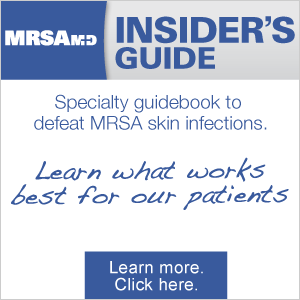What Is MRSA Colonization?
Overview
MRSA colonization is when bacteria reside on an individual, but there are no signs or evidence of infection. An individual colonized with MRSA bacteria is called a MRSA carrier. These individuals are unaware they are harboring MRSA.
MRSA colonization places you at risk for a MRSA infection.
MRSA Infections can develop days to years after initial colonization.
Why Is MRSA Colonization Important?
- Colonized individuals are at risk to develop a MRSA infection, and have the potential to transfer MRSA bacteria to others.
- MRSA colonization remains for years. In one study 20% of patients colonized with MRSA remained colonized after 4 years.1
- MRSA Infections can develop days to years after initial colonization. It is not known if delayed infections stem from the initial colonization or from new exposures.
- MRSA colonization in our communities – is a risk factor for skin and other serious infections.
- MRSA colonization in the hospital setting – is a significant concern in the following areas:
- Pre-surgical setting – colonization has the potential to increase post-surgical infections.
- Intensive care units – critically ill patients are in a weakened state to fight infection.
1-2% of the U.S. population is colonized with MRSA bacteria.
How Common Is MRSA Colonization?
- 1-2% of the U.S. population is colonized with MRSA bacteria.
- However, in specific populations, 20% or more of the individuals are colonized with MRSA. Populations with a high colonization rate range in age from infants2 to the elderly in long-term care.3
How Does MRSA Colonization Occur?
- Exposure to MRSA bacteria occurs through direct contact with a MRSA infection, or through contact with a person or object harboring MRSA.
- Hand contact is the most common form of initial exposure to MRSA bacteria, hence the importance of hand washing. The goal is to remove MRSA bacteria from one’s hands before colonization takes place.
- Colonization occurs when the bacteria are transferred to parts of the body that are difficult to keep clean. Colonized bacteria are found in the following areas:
- Nose – this is the most common site to harbor MRSA. Its warm, moist environment is ideal for bacteria.
- Fingernails
- Throat
- Armpit
- Groin
- Rectal area
Further Information
- For details on colonization and work/school limitations see “How Is MRSA Spread?” / “Can You Work or Attend School With MRSA?”
1 Duration of colonization with methicillin-resistant Staphylococcus aureus. Robicsek A, et al. Clin Infect Dis. 2009;48(7):910.
2 Relationship Between Maternal and Neonatal Staphylococcus aureus Colonization. Natalia Jimenez-Truque, et al. April 2012 online edition of Pediatrics.
3 Quantitative analysis and molecular fingerprinting of methicillin-resistant Staphylococcus aureus nasal colonization in different patient populations: a prospective, multicenter study. Mermel LA, et al. Infect Control Hosp Epidemiol. 2010 Jun;31(6):592-7.

